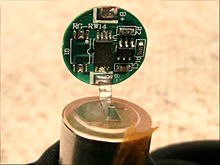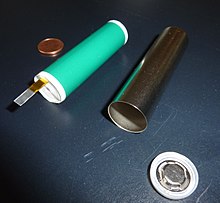Rechargeable battery
![]()
This article is about the energy storage device. For other meanings, see Accumulator (disambiguation).
An accumulator (short accumulator; also called secondary battery) is a rechargeable galvanic element, consisting of two electrodes and an electrolyte, which stores electrical energy on an electrochemical basis.
A single rechargeable storage element is called a secondary element or secondary cell, in contrast to the primary cell, which is not rechargeable (or only to a very limited extent). The charging process is based on the electrolytic reversal of the chemical reactions that take place during discharge by applying an electrical voltage. Like primary cells and all electrical energy sources, secondary cells can be connected together to form batteries, either in series (to increase the usable electrical voltage) or in parallel (to increase the usable capacity or because they are suitable for higher currents). Both circuit variants lead to a corresponding increase in the total energy content (product of capacity and voltage, specified in watt hours (Wh)) of the arrangement.
For each type of accumulator, the nominal voltage of the accumulator cell is determined by the materials used; as this is too low for most applications, series connection is often used to increase the voltage (see picture of starter battery). The capacity and the possible current, on the other hand, depend on the size. Therefore, a parallel connection of several cells is usually not necessary; instead, one uses a battery with appropriately sized cells.

Lithium-ion battery: monitoring electronics for over- and discharge protection

Cylindrical accumulator cell (18650) before assembly. A few thousand of these will be integrated and interconnected into a larger system called the traction battery to perform the energy storage function for the Tesla Model S electric car.
Clarification of terms
Accumulator
The Latin word accumulator means 'collector' (cumulus 'heap', accumulare 'to accumulate'). Originally, accumulator meant a single rechargeable storage element (secondary cell). Today, the term also refers - at least in common parlance - to rechargeable storage devices consisting of interconnected secondary cells. If the difference is important, more precise terms should be used:
- single storage element: secondary cell, secondary element, accumulator cell, accumulator cell
- interconnected storage elements: e.g. battery pack, battery of secondary cells
Battery
→ Main article: Battery (electrical engineering)
In the technical sense, a battery is a combination of several similar galvanic cells or elements connected together in series. There are batteries made of primary cells (non-rechargeable) and those made of secondary cells (rechargeable). Originally, batteries meant only those made of primary cells. Since the spread of rechargeable storage, this restrictive definition has become obsolete.
In colloquial language, however, battery serves as a generic term for (real) batteries, primary cells and secondary cells. It is therefore often referred to as "batteries" when actually only individual primary cells or secondary cells (accumulator cells) are meant.
Both types of cells are available in interchangeable sizes, and both are called batteries, which may add to the confusion. Rechargeable cells are called rechargeable batteries or accumulators.
Electrical consumers that can be operated with both primary and secondary cells are therefore often simply called battery-powered. Only when rechargeability plays a special role in the daily use of the device is the term battery-operated preferred. In the technical-scientific context, due to the dominance of English, one increasingly speaks of "rechargeable batteries" or "secondary batteries".
Capacitor
Capacitors are also storage devices for electrical energy, but they do not store it in chemical form but as an electrical field between their plates. Capacitors are therefore not accumulators in the conventional sense.

Nickel-metal hydride accumulator cells in standard format "AA" (Mignon)
History
The first preliminary form of an accumulator, which - in contrast to the cells of Alessandro Volta - was rechargeable after discharge, was built by Johann Wilhelm Ritter in 1803. The most famous type of accumulator, the lead accumulator, was constructed in 1854 by the physician and physicist Wilhelm Josef Sinsteden. In 1859 Gaston Planté developed Sinsteden's invention considerably further by arranging the lead plates in a spiral. At the turn of the 20th century, lead accumulators surrounded by wood fed electric drives for automobiles. The accumulator technology took a rapid development in the time. The following text published by the Telegraphentechnisches Reichsamt in 1924 shows this using the example of the then established telegraphy and still young telephony. Accumulators are called "collectors" here, and "batteries" were collections of galvanic elements:
"[In 1899], for the telegraph as for the telephone, wet and dry elements were the principal sources of current. For the telegraph, batteries were mainly made of zinc-copper elements; for the telephone service, wet zinc-carbon and dry elements were mainly in use. After 1900, collectors, which had been used in isolated cases since 1895 to operate microphones at the largest telephone exchanges, were introduced on a larger scale as more powerful power sources. [...] For charging the 12-cell battery, dynamo machines were set up at the exchange, which were equipped with their own power plant (usually light or heavy oil engines) or were driven from the local high-voltage network and supplied the required direct current in suitable amperage and voltage. Initially, alternating charge and discharge operation was generally used, i.e. one battery alternately fed the office while the other was charged. Later (1921) it was decided to take the current for the office directly from dynamo machines, whose electrical properties had to be specially adapted for this purpose, and to connect a 'buffer' battery in parallel with them."
Search within the encyclopedia